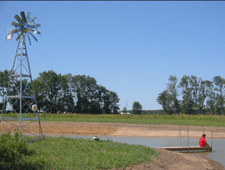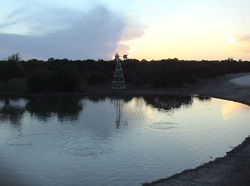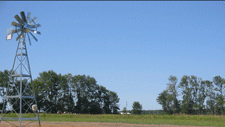Windmill-driven aeration works wonders for the water supply – and habitat
Fighting fire with fire is one thing. Fighting contaminants in ponds and lakes with harsh chemicals can be dangerous, expensive and ineffective. Yet the alternative – aeration equipment – can be too expensive to be cost-effective.

If you can catch the power of the wind with a windmill-driven aeration system, however, you can have the best of all worlds.
Whether due to algae blooms, animal waste or other problematic water chemistry, freshwater lakes and ponds can become perilously contaminated. Increasingly, managers and owners of ponds, lakes and reservoirs are turning to aeration as an alternative to harsh chemical treatments such as copper sulfate to eliminate those problems.
Windmill-driven aeration widely used in agricultural and recreational bodies of water due to its low capital cost and energy freedom is becoming increasingly popular in municipal applications such as water storage, golf courses and public parks.
Aerating the Attica reservoir
In Attica, N.Y., the water department caught onto wind power almost nine years ago. The 8.5-acre reservoir there, which holds approximately 50 million gallons of water, was contaminated with an influx of manganese and iron during the spring and autumn water turnovers.
“The condition was worst during the fall months when turnover would stir up iron and manganese that naturally occur in the reservoir,” explained Brian Krawczyk, chief operator at the Attica water plant. “But when there was high manganese and iron content and we treated the water with chlorine, we would get red water problems and constant turbidity (suspended particles).”
Krawczyk noted that the water treatment plant had used copper sulfate at the reservoir as an algaecide until a few years ago, when the New York State Department of Environmental Conservation issued new regulations on its application due to potentially toxic effects on fish, swimmers and the surrounding habitat.
“We did quite a bit of exploration on the [Internet], and aeration appeared to be the best solution,” Krawczyk said. “Oxidation would solve the manganese problem, and there are harsh chemicals that will provide that. But we didn’t want to use harsh chemicals. Plus, the reservoir is in a remote location, so chemical treatment wasn’t a good solution anyway.”
Constructed in 1928, the Attica reservoir is a manmade lake that is fed by the surface waters of Crow Creek, and is located in a wooded area – miles from the water treatment plant. The remote location also made running power to an electric aeration device problematic, although the water department wanted to avoid the cost of energy anyway.
“We considered other options as well,” Krawczyk added. “We had a couple of air compressors at the water treatment plant, and weighted the possibility of running air lines from the compressors all the way back to the reservoir. Another option was to run power back there and house the compressors there at the reservoir. But either of those choices was going to be brutally expensive and a logistical nightmare. The terrain between the treatment plant and the reservoir is full of big ravines and is just a mess.”
When researching aeration, Krawczyk came across the Web site of Koenders Windmill, the parent company of Regina, Saskatchewan-based Superior Windmills.
Krawczyk was impressed by the simplicity and efficiencies of the company’s windmill aeration system. Krawczyk learned that Superior’s windmill aeration system was simple to construct and self-install, had relatively few parts, required little maintenance and required no electric power. The logistical considerations were not an issue, since the system is completely self-contained and ideal for remote locations.
“The windmill aeration system couldn’t be a simpler design,” Krawczyk said. “The wind creates a rotary motion that is converted by the windmill to a reciprocating motion. It pumps a diaphragm and that pumps air into the reservoir. So, it appeared to be a perfect fit for us.”

Krawczyk also was attracted to the fact that the constant-aeration windmill keeps the water fresh because it pulls water down from the top and then sweeps it across the bottom and pushes it up as a column of air. The effect is similar to turnover that is occurring at all times, keeping the water oxygenated.
Still, there were two important considerations before making a final decision on the windmill: height and footprint.
“The reservoir is located in a wooded area that is sheltered by trees,” Krawczyk said. “There are not a lot of clearings. We had to keep the windmills at a relatively low height – 12 feet – so that we could catch the air currents as they move across the water. Even though the reservoir is located in a bowl and there is not a whole lot of air moving in the area, just a relatively light breeze will keep the windmills spinning.”
The other problem was that the reservoir is contained by an earthen dam that is fairly narrow, so the windmill needed to have a relatively small footprint. The bigger the windmill tower, the bigger the footprint, so the 12-foot tower was a good solution for both footprint and height.
The Attica water department purchased five windmill aeration systems. Three were installed at the primary reservoir, and one for standby. The fifth windmill eventually was disassembled and converted to a water wheel that continuously flows and aerates water at a secondary reservoir.
Krawczyk is pleased with the performance of the systems, including the low maintenance requirements.
“We seldom run into any repairs,” he said. “We just grease the pivots each year. We recently replaced the diaphragms and checks valves, which was simply routine service. We will probably go for two to three years without having to service them again.”
Seeking aeration in Seattle
Many golf courses have beautiful ponds as water hazards or landscape features. However, due to lack of water aeration, rotten and unpleasant smells often are emitted from them, and they can easily become cloudy and dirty looking. In addition, these stagnating ponds are prime breeding grounds for mosquitoes. With West Nile virus being a concern on every golfer’s mind, it is important to keep ponds clean and well-circulated.
At the Interbay Golf Center in Seattle – a combination golf course, driving range and other recreational complex – a 15,000-square-foot pond has algae problems throughout the summer months. The pond is a relatively shallow water-retention facility and a wildlife shelter that, along with the course, is registered with the Audubon Cooperative Sanctuary Program for Golf Courses.
Ever since it was built, the pond has been a magnet for ducks and other birds; the waste from them rapidly contributed to the growth of algae. Golf course Superintendent Rocky Tharp said his crew tried “beneficial organisms” as an alternative to chemicals, but had no luck with them.
“To protect the habitat, we are trying to get away from using chemical treatments like copper sulfate and herbicides,” Tharp explained. “We built this pond as a small ecosystem that is part of an environmental case study. So we don’t want to be spraying ducks and geese with copper sulfate.”
If sufficient oxygen were pumped into the pond, Tharp thought, that would overcome any algae problems and help to reduce sludge on the bottom of the pond.
“So, in addition to increasing the pond biodiversity and adding oxygenating plants, we decided to try some type of aeration system,” Tharp explained. “But, of course, the electric-powered aerators can be expensive to purchase and install, especially if you don’t have a nearby power source. So, we decided to try the Superior Windmill aeration system because it is relatively inexpensive, costs nothing to operate and will have less environmental impact.”
Tharp added that if the windmill aeration system – now being installed on the golf course – works for that pond, it could lead the way for application in other parts of the Seattle Parks and Recreation Department that have water features.
Ed Sullivan is a technology writer in Hermosa Beach, Calif. Sullivan wrote this case history on behalf of Regina, Saskatchewan-based Superior Windmill. The views expressed in this case history do not necessarily represent those of GovPro.com or Penton Media.



















